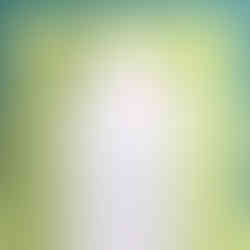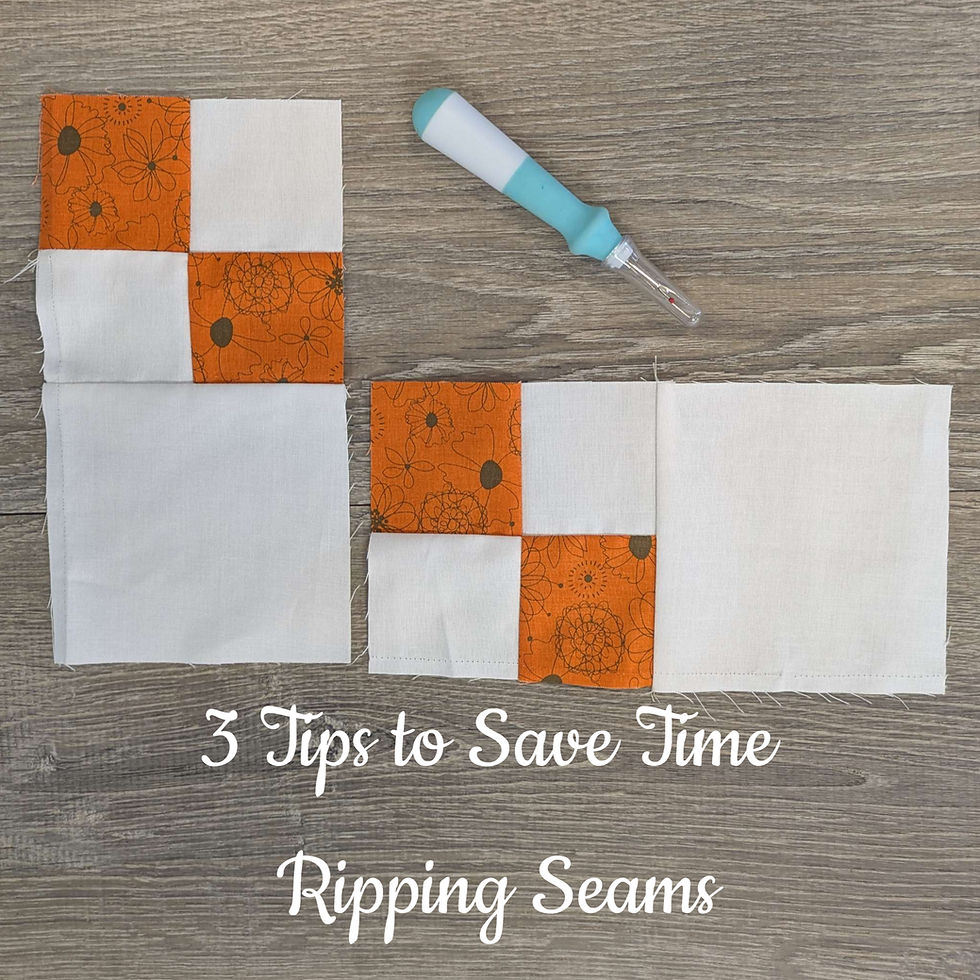Nothing but Love Quilt Along - Patience
- Tara Wright
- Jul 6, 2022
- 8 min read
Updated: Aug 14, 2022
Hi friends! We've made it to the last quarter of our quilt-along! Today we start off the final four with a house block named Patience. This traditional block is made with two new techniques - improvisational piecing and reverse applique.

This pattern allows you to make many choices to customize your 3 little houses and give your little neighborhood it's own pizazz! I hope you're excited to try some different methods. And remember patience - with yourself, with others, and with neighbors - is a virtue.
The Block Pattern

The theme for this week's block is IMPROVISATION - there is no set color, shape, or placement for certain aspects within the patches. The personal choices for Patience include fabric placement, rotation of the 2 smaller houses in the block setting, roof shape and style, and size, number, and placement of the heart windows. I hope you enjoy this process and have fun making this block uniquely yours!

I hope you can see some of the differences already in the choices made in my 2 blocks.
Due to the slightly more complex explanation of improvisational methods, you will find this pattern to be several pages long plus the windows template is included. So load up several pieces of paper and click on the link below to download and print the pattern for Block 13 - Patience:
If you have any questions or issues with downloading please ask here or on the contact page.
Traditional Piecing with a Twist
The bodies of each house are made with traditional piecing. For two of the houses you are simply sewing sides onto the building. The third house is the full width of the patch, so there is no piecing.
The main thing to note for this first section of the pattern is that two of the houses require a layering of fabric. This is for the reverse applique process that comes later.
So for House A and House C simply place your two house body fabrics with the "house exterior" fabric on top and the fabric that will "peek" through the windows underneath it. Both fabrics should be right side up so we see the pattern. For House C since there is no piecing you can baste it in some way - pins, stitched, or spray.

Improvisational Piecing - Making the Rooftops
In making the 3 rooftops there is no set shape or size provided by me. You are going to decide do want:
A triangle shape or more like a trapezoid (flat top) shape,
A symmetrical (same on both sides) roof or asymmetrical roof, and
A narrow roof or wide roof?
Then you will use improv (-isational) piecing to create the desired shape. Basically, you are replacing the corners of your roof fabric piece with the background fabric. The skills used for this are similar to the ones used with the foundation paper piecing and stitch and flip methods.
Referring to the pattern while looking at these pictures should help to illustrate the technique. You can see on this example I marked both roof lines to help me picture it before sewing. When placing the fabric, start with the fabric edge on the line and pattern side up. Check that the roof fabric corner is covered by at least 1/4" past the corner edges. Then flip the background fabric over so the pattern side is now down with fabric edge still on the marked line. Last, move your background fabric piece in the direction of the corner until it is 1/4" past your marked line. When you sew this will create your 1/4" seam allowance.
When adding the second corner, mark the sew line so that it crosses your first roof line by at least 1/4" below the top edge of the fabric to make the peak. This will make your marks look like an X at the top (See photo 1 below). When your fabrics overlap this will allow you to keep your peak when you sew the patches and blocks together.
After you have stitched, it's time to cut away the extra roof fabric.
Fold over and press your newly sewn background fabric well and then flip the entire piece to the backside.
Then place any corner of your ruler along the corner of the original fabric piece (the roof fabric). Using your rotary cutter, trim off any background fabric parts that spill past the original corner.
Then flip back to the front side of the piece.
To remove the excess fabric (because there are currently 3 layers), fold the top background over and out of the way. Place your ruler so that the 1/4" mark is on the stitched seam line and the edge is 1/4" past the stitches on the side of the corner.
Then trim off the extra background and corner fabrics with your rotary cutter.
Lastly, fold your top piece of background fabric back into place.
Press your seam open if you like. If you prefer not to then keep it all on the same side as the corner.
Repeat for second side of roof.
Once you have completed the first roof, then repeat this process for the other 2 rooftops. Most background fabric pieces have a "long side" which is what you would place along the marked line. In the example above (green) I made my roof more symmetrical, so I completed it using more of a stitch and flip method. I basically laid one background square in the corner, sewed on the diagonal, flipped, and trimmed. This works because the longest side of a square is the diagonal.
**Remember your pieces do NOT have to meet and form a point in the center, there can be a flat part. The roof peak does NOT have to be at the very top of the rooftop piece, it can be more centered. And the bottom corners do NOT have to go all the way to the sides of the fabric, they can be inset.
When you are finished making all three rooftop patches, you can sew them to their matching house bodies using traditional piecing - matching the fabric edges and using a 1/4" seam.
Reverse Applique - Adding the Windows
Adding the little heart windows should be the most fun part! If you're not very familiar with applique, usually the fabric pieces are stitched on top of a base fabric like we did with the Smitten block. This time we are revealing and underlying shape, so we are going in reverse. In this pattern since you are able to choose where to place the windows, the number of windows, and how large to make them I had you place the underlying layer under the entire section, but that may not be the case in any future patterns you try.
So what we are going to do is stitch a heart or hearts onto your layered section:
House A - house body
House B - rooftop
House C - house body
I provided templates and 3 different methods to stitch the heart shapes in the pattern. I do recommend using the free motion foot just because the hearts are not very big, but you can use your walking foot as long as you realize there will be many stops and pivots around the curves.
Number of windows: I would suggest putting only one heart window on the smaller houses, but you can put additional windows on House A since the body is so tall. You can see on the green block I chose to do two windows.
Location of windows: They do not have to be centered, but I suggest not getting super close to a seam line since you don't want to expose the seam allowance fabric when you remove the top layer.
Shape of windows: the template options provided are tall, short, skinny, fat, large, and small so you can make any choice that fits in the area you choose. You can make multiple copies of the template if needed. You can also draw your own template on paper or on your fabric with an appropriate marking pen.
Once you have stitched your windows into place and tied off any loose thread ends, it's time to reveal the underlying fabric. This is similar to our fusible applique in Block 2 - Refuge.
You need to carefully tent or separate the two layers of fabric within the stitched heart. Use very sharp and pointy snips to make a hole in the heart window's center. Then maneuver your scissors to cut approximately 1/4" away from your stitched line. Do this for every window and your houses are complete!

Finish your Block
I know these explanations are lengthy, but the actual construction is not, so I greatly appreciate your patience (LOL - I couldn't resist)!
All that is left is putting your houses together into one block - sew the two little house into a row and then sew that row to the tall house using traditional piecing and 1/4" seam. So there is one choice left - which way do you want your houses to point? I wanted to take this opportunity to show you some alternatives to all the houses pointing in the same direction.
I hope you're not too tired from making all of these improvisational choices!
Be a Share Bear and Join the Fun
I'd love to see your block choices - ALL that improv! You can share a picture... here on the blog comments or on Facebook or Instagram.
Tag me @polkadotpeepquiltsetc and use the tags #nothingbutloveQAL and/or #patienceblock in your post so I can find you. There are link buttons to my Instagram and Facebook on my website as well if you'd like to follow me.
You can also sign up and join my community here on Wix (or the Wix Spaces app). There are soon to be some extra goodies there for users.
This week there will be another bonus block pattern for the border, and next week I will be discussing and demonstrating a new quilting motif.
If you're new here, here is the quilt along schedule (with links for you to catch up anytime):
Nothing but Love Schedule
December 20, 2021 - Quilt Along Intro & Details
January 10, 2022 – Get Ready: Prep the Fabrics & Batting
January 17-Block 1
January 31 - Block 2
February 14 - Block 3
February 28 – Block 4
March 14 – Block 5
March 28 – Block 6
April 11 – Block 7
April 25 – Block 8
May 9 – Block 9
May 23 – Block 10
May 27 – BONUS Block for Border
June 6 – Block 11
June 20 – Block 12
July 6 – Block 13/Patience
July 8 – BONUS Block for Border/Stitched Together Unit
July 18 – Block 14/Comfort
August 1 – Block 15/Grateful
August 15 – Block 16Hopeful
August 29 – Border/Enamored
September 12 - Sashing It All Together & Finishing Details
**Each “between block” Monday there will be a post for quilting the blocks:
January 24, February 7 & 21, March 7 & 21, April 4 & 18, May 2 & 16 & 30, June 13 & 27, July 11 & 25, August 8 & 22, September 5
Have fun making your blocks & doing summer-y fun things!
Be blessed my friends,
Tara






































Comments